Dear children!
Today I invite
you to CONVERSION.
This is the most
important message that I have given you here.
(Message, February 25, 1996)
Medjugorje is unique
an event in the history of the Church and the history of apparitions if nothing else, only because
of the number of apparitions.
For if this teaching or this work is of men, it will come to nothing:
But if it is of God, you will not be able to overcome them, and you are in danger of fighting against God.«
(Acts 5,38-39)
Recapitulation of Medjugorje messages
The messages given in the first seven days of apparitions and the four sets-groups of messages available to the
public were processed:
- messages, tj. Our Lady's words of the first days of the apparition. There are 4 messages extracted from Our Lady's conversation with the children on June 26, 27, 28 and 29, 1981.
- messages for the parish which the visionaries received mainly on Thursdays in the period from March 1, 1984 to January 8,
1987. In that period, 158 messages were published.
- messages on the "25th of the month" which replaced the weekly messages for the parish.
These messages were published in the period from January 25, 1987. to 25.04.2025. and with that
date they are processed . There are 459 of these messages on 25.04.2025.
- messages on the "2nd of the month" through Mirjana Soldo. These messages were published in the
period from December 2, 2007. to 02.03.2020. year when the last message was published. There are 139
of these messages.
- so called "Annual messages for Mirjana, Ivanka and Jakov". There are 89 of these messages.
So, the first seven days of apparitions, and in the period 01.03.1984.-25.04.2025. a total of 843 messages
were published.
The main messages of Our Lady in Medjugorje are: peace, faith, conversion, prayer, fasting...
BROWSE BY MESSAGES
The most common terms that appear in these messages are as follows:
Note: click on the word for a detailed overview
- PRAYER is mentioned in 643 messages. Our Lady 1466 times uses the word PRAYER , and She herself uses the word "..I ask of you.. " or "..I pray for you..." 171 times.
Our Lady mentions the rosary 23 times and the prayer with the heart 39 times
- FAITH is mentioned in 147 messages. Our Lady uses 246 times the word FAITH, and 10 times the word unbelief.
- PEACE is mentioned in 274 messages. Our Lady 500 times uses the word PEACE in these messages
- Holy Mass / Eucharist is mentioned in 24 messages. In these messages 38 times he uses the word MASS / EUCHARIST
- CONVERSION is mentioned in 139 message. In these messages Our Lady uses the word CONVERSION 175 times
- THE BIBLE / Holy Scripture is mentioned in 17 messages. In these messages Our Lady uses the word BIBLE / Holy Scripture 18 times
- The Holy SPIRIT is mentioned in 71 messages. In these messages, Our Lady mentions the HOLY SPIRIT 87 times
- FASTING is mentioned in 62 messages. In these messages Our Lady uses the word FASTING 74 times
- CONFESSION is mentioned in 18 messages. In these messages Our Lady uses the word CONFESSION (reconciliation with God ..) 21 times
- SERIOUSNESS is mentioned in 17 messages. In these messages Our Lady CALLS FOR SERIOUSNESS in accepting Her messages 18 times
- "DON'T BE AFRAID" is mentioned in 40 messages. Our Lady encouraged with the words: DO NOT BE AFRAID 47 times
- FAMILY is mentioned in 63 messages. In these messages, Our Lady speaks of the IMPORTANCE OF THE FAMILIY and uses the word FAMILIY 85 times
- HOLINESS is mentioned in 97 messages. In these messages, Our Lady calls for HOLINESS and uses the word HOLY or HOLINESS 132 times
- BE GOD's / MY EXTENDED HANDS! is mentioned in 16 messages. In these messages,
Our Lady mentions-PRAY-CRY : "Be God's / my outstretched hands!"
- CROSS is mentioned in 35 messages. In these messages, Our Lady speaks about CROSS 52 times
- BE WITNESSES is mentioned in 125 messages. Our Lady uses this word 146 times.
- Why have I been with you for so long ... is mentioned in 12 messages.
Note:
The number of words that appear in Our Lady's messages is based on the original messages in the Croatian language, so
that when translated into other languages, this sum may be different.
MEDICAL AND SCIENTIFIC STUDIES ON APPARITIONS IN MEDJUGORJE
June 27, 1981 - by order of the communist authorities, the first medical examination of the seer was performed in the clinic in Čitluk.
The visionaries were examined and examined by Dr. Ante Vujević.
Dr. Vujevic DID NOT FIND THAT THE VISIONARIES WERE IMMALENT.
June 29, 1981 - visionaries taken to the Psychiatric Clinic in Mostar. They were examined by Dr. Džudža .
According to Vicka, Dr. Džudža said: “Those who brought you here are crazy. You are
completely normal - healthy. "
Official reports from these first two reviews are not available.
Slavko Barbarić, PhD in social psychology with a doctorate from the University of Freiburg, published in 1982 a methodological
analysis of a group of visionaries in the collection "Kršni zavičaj" No. 15, which was also published in Italian
under the title "Le apparizioni di Medjugorje “ Milan, Mimepdocete 1984. , pages 88-105.
The study showed that the apparitions have no sign of hallucinations: neither the character, nor the mental appearance
of the young people, nor their past, nor their living conditions indicate that, and all subsequent tests exclude that.
Dr. Ludvik Stopar, psychiatrist and parapsychologist, director of the polyclinic in Maribor, Slovenia, observed the
seer on 4 occasions; in May and November 1982, and in June and November 1983.
The conclusions of his parapsychological research are:
- Experimental tests: neuropsychiatric, medicopsychological and somatological show that these young
people (seers) are completely normal without any pathological sign. The hypnosis to which he subjected
the seer Mary confirmed the complete agreement between conscious and automatic speaking (in hypnosis),
which precludes pretense and manipulation. These phenomena express an objective character
attributed to some higher - transcendent - origin.
He sent his report in December 1984 to the Episcopal Ordinariate in Mostar:
“I ask that the church commission at the church court in Mostar be assigned the task of starting
the canonical process, in which the events in Medjugorje will be clarified and objectively-critically
interpreted, to come to the conclusion that these phenomena are theistic-parapsychological, not no
human manipulation and that they are transcendent.”
Dr. Philipe Madre, Castres, France, observed the visionaries from August 23, 1983 to August 25, 1983.
He gave only an intuitive assessment which is unconditional as to the physical and mental health of the seer.
During 1984, a large number of Italian doctors resided in Medjugorje.
- Dr. Maria Frederica Magatti witnessed the apparitions of 3-4. February 1984 and March 22, 1984.
Her main assessments: “We can talk about ecstasy because visionaries lose contact with the world around them.
The seers remained insensitive to stimuli: when someone called them, touched them, pinched them;
there is no answer even when someone stabs them with causing pain. One cinematic reflector with
approximately 1000 watts is turned towards their eyes without their pupils changing diameter.
During the apparition, the application of the neurovegetative system is not observed, the heart
rate is not changed ... A spontaneous activity of the movement was seen that remains conscious:
especially the movement of the lips in conversation with the being of the apparition. From all
this it can be concluded that the seers are neurologically completely normal despite the severance
of the conscious connection with the outside world. (u M.Botta , Le appararizioni di Medjugorje,
Pessano, Milano . Miemp-Docete 1984. pages 85-86).
Dr. Lucia Capello witnessed the apparitions of 5-6. February 1984, and March 23, 1984.
In an article published in Le appararizioni di Medjugorje, 1984. p. 87-88. Dr. Capello writes
about what she calls the "three synchronicities" (simultaneity of key moments of ecstasy) :
1. Seers fall to their knees as their voices "disappear" even though their lips shape some speech
2. Their voices reappear at the same time in the Lord's Prayer beginning with the third word: the
first two are begun by the person appearing.
3. The heads and eyes are raised at the end of the apparition at exactly the same time.
The second and third simultaneities are inexplicable to natural causes and point to causes noticeable
only to the seers and not to the observers.
Dr. Mario Botta, a cardiologist surgeon, Milan, Italy, was present at the apparitions on December
8 and 9, 1983.
In addition to recording Ivan's cardiogram, an experiment with painful stimulus-pinching showed
complete visionary insensitivity to these stimuli. Dr. Botta recorded Ivan's cardiogram with
the conclusion: “Ecstasy does not nullify normal physiology but transcends it, placing seers
in the background. It is completely impossible to study apparitions with the help of signs
of a medical diagnosis. The apparition seeks and calls for an opening to the faith, the call
of Our Lady which the seers claim to be revealed to them. "
Dr. Enzo Gabrici, a neuropsychiatrist, was present at the apparitions on April 3-8, 1984.
His conclusion: “Clinical observation excludes the occurrence of hallucinations, any sign of
epilepsy or any other disorders that are capable of causing changes in consciousness. There
are no signs of hypnotic suggestion, which ends in forgetting what was experienced under hypnosis;
the seers can recount very wittily all that has happened to them. Unlike spiritistic media
dominated by another personality, seers maintain a perfect awareness of their identity.
They listen to their own personality. Their indifference to the surroundings that surrounds
them comes from the fact that they are completely obsessed with apparitions. Psychoanalysis
does not shed light on this state of consciousness. Observation does not bring any element
that casts doubt on the credibility of a healthy observation. "
Prof.dr. Anna-Maria Franchini was present at the apparition on April 5, 1984.
Her conclusion: "In the group of seers, everyone is independent and takes their own stance, but
they are all attracted to some external object that directs and determines their attention and
their interest in a strong level of intensity I have never seen before and which is an essential
sign of experimentation."
Father Nikola Bulat, professor of dogmatics at the Split Theological Seminary, was present at the
apparition on June 2, 1984.
During the apparition, Father Bulat stabbed Vicka in the area of his left shoulder blade with a
long needle. Vicka did not show the slightest trace of pain, or sensitivity to the sting. Father
Bulat repeated the same procedure once again, and there was no reaction from Vicka. After the
apparition, the site of the sting on Vicka's blouse was marked by a small bloodstain with a
diameter of just over 1 cm. The whole event was documented on videotape. Prof. Joyeux looking
at the footage, said the sting must have been painful and that under normal circumstances Vicka
would have had to scream. This is just one of the proofs of insensitivity to external stimuli that
accompanies the ecstasy of visionaries in Medjugorje.
The same experiment with needle pricks in the body was performed on Bernardica Soubirous at the
apparition in Lourdes on February 23, 1858. with the same effect as on Vicka: complete
insensitivity to external stimuli.
The team of French doctors who performed research on visionaries in Medjugorje are:
Prof. Dr. Henri Joyeux Professor of Cancer at the Medical School of Montpellier
Dr. Jacques Philippot, internist, graduated in ophthalmology, Montpelier
Dr. Francois Rouquerol, graduated in otorhinolaryngology, Montpelier
Dr. Bernard Hoarau, internist, Montpelier
Dr. Renaud Volpiliere, Head of the Cardiology Clinic, Montpelier
Dr. Jean Cadilhac, Professor of Experimental Medicine, Neurologist and Neurophysiologist, Montpelier
The tests were performed over 4 time periods:
-March 24 and 25, 1984
-June 9 and 10, 1984
-October 6 and 7, 1984
-December 28 and 29, 1984
Clinical and paraclinical trials were performed 30 minutes to 1 hour before ecstasy, during ecstasy,
and 10-15 minutes after ecstasy.
The following searches were performed on the visionaries during the apparitions:
-electroencephalogram with Alvar Electronic - Reega Minihuit
-experiments on the eyes with SLI (Stimulation Lumineuse Intermittente) device
(examination of the inside of the eye and possible irregularities and photomotor reflexes).
- PEA 1010 hearing test.
-electrocardiogram, recording of heart rhythm and arterial pressure
-all tests were recorded with video cameras
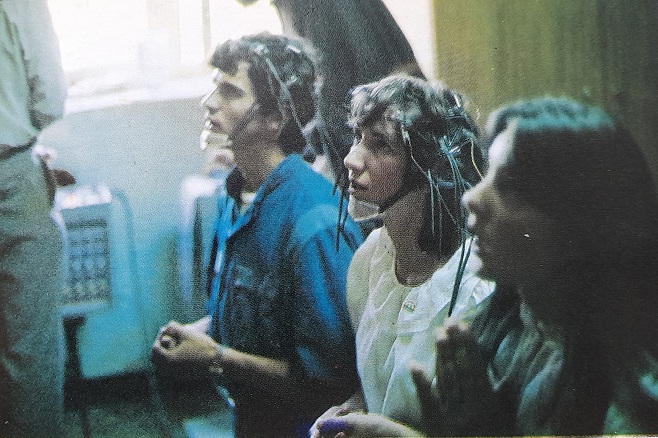
Ivan , Marija and Ivanka - Apparition 10.06.1984. - recording of Ivan's and Marija's electroencephalogram
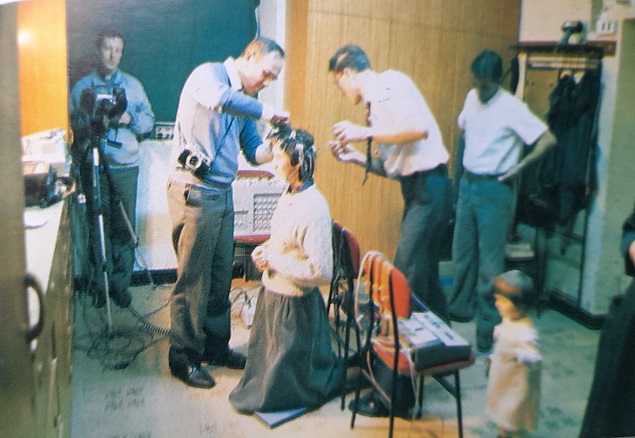
Marija - preparing for recording of electroencephalogram before the apparition 06.10.1984.
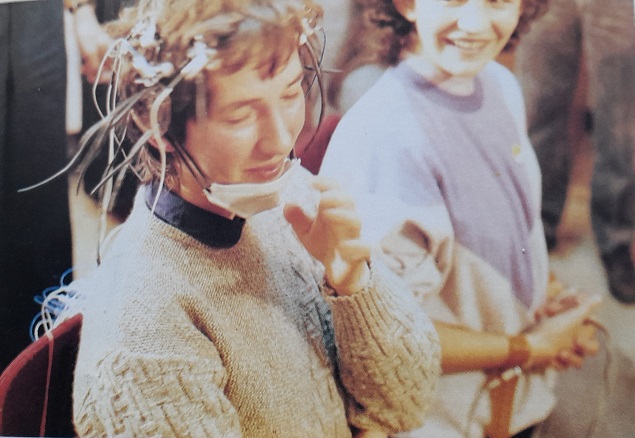
Marija and Vicka before the apparition 06.10.1984.
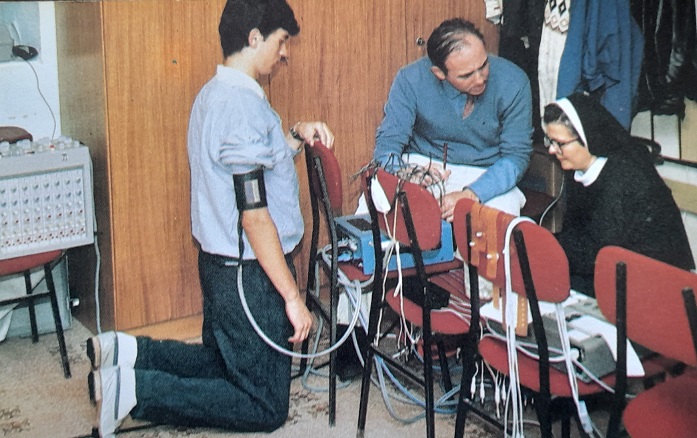
Ivan and professor Joyeux before apparition 07.10.1984. - Recording heart rate and arterial pressure
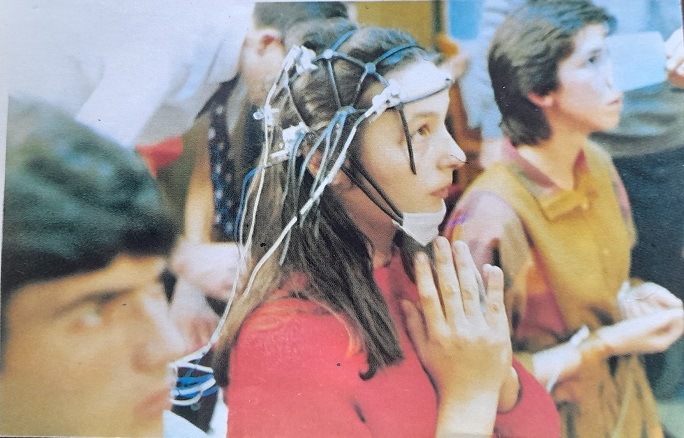
Apparition 07.10.1984.-Recording of Ivanka's electroencephalogram and a test before Marija's eyes
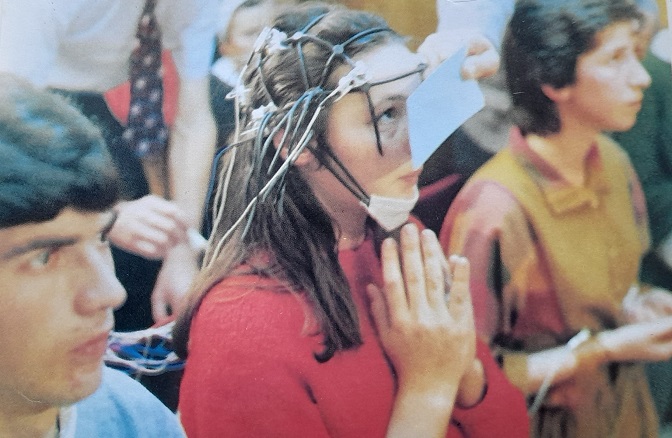
Apparition 07.10.1984.-Recording of Ivanka's electroencephalogram and a test before Ivanka's eyes

Ivan and Marija before apparition preparing for oculogram 28.12.1984.
EXPERTISE CONCLUSIONS - EXPERT OPINION
The appearance of apparitions in Medjugorje (Yugoslavia), studied in different periods in 1984 by
five seers, proves to be scientifically inexplicable. Clinical observation of the visionaries
allows the claim that these young people are normal, physically and mentally healthy, as
established by the Yugoslav brethren before us. Careful clinical and paraclinical studies
performed before, during and after ecstasy make it possible to scientifically determine that
there is no pathological change in the objectively studied parameters: electroencephalogram,
electrooculogram, electrocardiogram, auditory stimuli.
- It is not about epilepsy - electroencephalogram prove
-it's not a dream - electroencephalograms prove
- it's not about daydreaming, apparitions - electroencephalograms prove
-it is not a question of hallucinations in the pathological sense of the word.
There are no hallucinations when it comes to hearing and vision, which would be related to some
abnormality in the area of the extreme (peripheral) sensory receivers (hearing and vision pathways
are normal).
There are no hallucinations that bear the marks of apparitions that can be observed in
major mental disorders or during the development of atrophic insanity.
-it is not hysteria, neurosis or pathological ecstasy, because the seers do not have any symptoms
of these diseases, whether they be of any clinical form.
-It is not a case of catalepsy (stiffness) because during ecstasy the facial muscles are not locked,
they work normally.
The movements of the eyeballs in visionaries stop at the same time at the beginning of ecstasy
and again at the end at the same time (exactly in a second) they begin their work again.
During ecstasy, there is the same direction of gaze, as a face-to-face relationship between
the seers and some person we have not seen. These young people always have a behavior that
is by no means pathological; during ecstasy they are in a "state of prayer" and interconnected.
In Medjugorje, ecstasy is not pathological and there is no fraud. No branch of science seems
appropriate to us to pinpoint these phenomena. For our part, we would define them as a state of active,
powerful prayer, which is partially disconnected from the outside world, a state of contemplation
and a meaningful and healthy connection with a special person that only they see, hear and can touch.
Title of the French original from which the text was taken:
Professor Henry Joyeux
Father Rene Laurentin
Etudes Medicales et scientifiques sur les apparitions de Međugorje
Croatian translation: Liječničke i znanstvene studije o ukazanjima u Međugorju, Sveta baština - Duvno 1986.
Bishops and Cardinals talk about Medjugorje
Source: Glasnik Mira, Year XI. • No. 6 • June 2016 - 35th anniversary of the apparitions
Msgr. Gabriel Gonsum Ganaka, Archbishop of Jos, Nigeria
As Archbishop, I wanted to tell everyone who has not yet come to Medjugorje that they should do so and make sure,
rather than listening to the stories of others or creating prejudices about what they don’t know. Only then can I create
own court.
Meeting the visionaries and priests who work here, I see fruits that I highly respect and that
they inspire me.
Msgr. Andre-Mutien Leonard, Archbishop, Namur, Belgium
I came, saw and convinced myself of the veracity of what was happening here. The fruits of Medjugorje are blessed fruits.
Msgr. Georges Lagrange, Archbishop, Gap, France
I want to say that in the world today there are many conflicts between religions and peoples, and in these areas they have come to the fore.
I believe that is why the Blessed Virgin chose Medjugorje as a place of complete and true reconciliation.
Msgr. Henry Joseph Keneddy, Archbishop, Sydney, Australia
I want the Church to recognize Medjugorje as soon as possible, like Lourdes and Fatima.
In Medjugorje, there is peace and a beautiful friendly flow among the people who
would also like to feel among the people of Australia.
Msgr. John Baptist Odama, Archbishop, Gulu, Uganda
I want to say that the first thing I will say to the bishops is that Medjugorje is not contrary to what the Lord teaches us and from what
what he wants from us. I'll tell them they're not afraid to come here. As for apparitions, they are a gift from God.
It would be good for every bishop to come and experience what Mary is doing here and show us what to do.
Msgr. Seamaus Hegarty, Archbishop of Derry, Ireland
You need to recognize works by their fruits. And the fruits here are so distinctly clear and impressive that
cannot be ignored. For me, the most important moment in Medjugorje was while listening to confessions
and I'm sure in those three hours I heard more meaningful confessions coming from the depths of my heart,
than in the twenty-first year of my priesthood.
Nothing else could have happened to me except that it touched me deeply clearly
the action of divine grace.
Msgr. Mario Peressin, Archbishop, L’Aquila, Italy
I cannot deter people from making a pilgrimage to Medjugorje because I have seen those who have returned converted,
and they did not attend church for ten, fifteen, or even twenty years.
Msgr. Daniele Ferrari, Archbishop, Chiavari, Italy
We should strive that from now on everyone can read and live the messages that Mary sends us through the seers.
This is possible if we include them in safe sources of religious revelation and church doctrine ...
These messages can overthrow tyrants. They correct some pastoral programs that are us, and yes
we did not even modestly feel it, it led us to attach more importance to plans and theoretical discussions
than prayer, fasting, and the calling of the Holy Spirit.
Msgr. Ruben Hector Di Monte, Archbishop, Buenos Aires, Argentina
In Medjugorje I find a deep spirit of conversion, a spirit of prayer and penance. Our Lady's messages are evangelical - prayer,
fasting, conversion. In all previous apparitions, as well as in Medjugorje, the Mother repeats the same message of Christ.
By living that message, the message of Christ, peace becomes possible, and a change of heart through prayer and conversion
they alleviate divine righteousness.
Cardinal Jean Margeot, Port Louis, Mauritius
I am leaving Medjugorje satisfied with the lived experience.
Msgr. Giuseppe Casale, Archbishop of Foggia-Bovino, Italy
Medjugorje is a very serious reality, calling for a change in one's own life.
No one here can remain indifferent. I will come again to deepen my faith.
Msgr. Frane Franić, Split - Makarska, Croatia
I have been to Medjugorje several times and I am convinced that the visionaries are not lying ...
We bishops, as a bishops' conference, have stated that we will not organize official pilgrimages,
but we allowed private pilgrimages. I find no reason why we should forbid pilgrimages to believers. I met
thousands of pilgrims, including about twenty bishops from Germany, Italy, France, America, Egypt,
who visited Medjugorje, not officially, but privately.
The pilgrims return from Medjugorje with new courage and great enthusiasm.
Msgr. Joseph Devin, Archbishop of Montherwell, UK
In the fruits I see proof of the authenticity of the apparitions. While in Lourdes, and despite the
apparitions being recognized, the local population lives in a pagan way, in Medjugorje most of the
inhabitants go the way of salvation.
Msgr. Joseph Gray, Bishop of Shrewsbury, UK
I know that the message of the Mother of God in Medjugorje was the reason why the Pope wanted the Marian Year.
I know that the Pope personally, privately, acknowledges the apparitions of Medjugorje
because they have been verified through their fruits.
Mons. Denis Brown, Bishop of Hamilton, New Zealand
I want to tell everyone to come to Medjugorje if at all possible and to experience the prayer atmosphere here.
It is not only the seers who make Medjugorje, but the faith of the pilgrims. Here you are carried by the prayer of
the pilgrims, and this is what God speaks through his people. I would tell everyone to come here and feel what it
means to be a people of God. (Glasnik mira, Volume IX. | number 7 | July 2014. p.17.)
Emilio Ogñénovich, retired Archbishop of the Archdiocese of Mercedes-Luján, Argentina
Unfortunately, there is still too much ignorance in the Church about this great supernatural
reality in Medjugorje in the middle of the modern world. Hope, however, is given to me by the words of John Paul II, who told us, the priests and bishops, to follow the
pilgrims to Medjugorje because they pray, convert, fast and change their lives.
The church will need more time to express its position on Medjugorje, just as in its wisdom it
took time to express its position on Fatima and Lourdes. As for Medjugorje, I will share my personal
conviction with my brothers, the Bishops of the Argentine Bishops' Conference and our Primate,
Cardinal Bergoglio, who was very happy when I told him that I was going to Medjugorje.
(Glasnik mira, June, 2006 / No. 6 / Vol. I, p. 26)
Cardinal Emmanuel Wamala, Kampala, Uganda
The memory of my pilgrimage to Medjugorje still lives in me. My experience of that holy place could
be summed up in three points: prayer, penance, and communion in faith.
It seems to me that these are the main features of Medjugorje. You truly have reason to be thankful to God.
We share with you our common joy.
Mons. Jean Damascène Bimenyimana, Bishop of the Diocese of Cyangugu, Rwanda
When I came, I felt that God was present here. Medjugorje is a place of prayer and conversion,
a place where extraordinary opportunities for prayer are offered.
Cardinal Ersilio Tonini, retired Archbishop, Ravenna-Cervia, Italy
Thousands of pilgrims come to Medjugorje, pray, faith is revealed. It is one great gift
and therefore we thank God.
Cardinal Bernardino Eccheverria Ruiz, Quito, Ecuador
I am so happy to have come to Medjugorje. God speaks here through Mary to all nations and all cultures.
You don't come here for tourism. You come here for confession, to meet God.
This is a divine moment for the world. I personally feel here the beginning of the conversion of the whole of Europe.
Msgr. Gaetano Alibrandi, Dublin, Ireland
I found a lot of spiritual refreshment and encouragement in Medjugorje. I recommend again all my
needs many of which are difficult.
Msgr. Michael David Pfeifer, San Angelo, Texas, USA
No one would expect Medjugorje, like Nazareth, to become a center visited by people from all over the world.
Thousands of pilgrims, coming to this Croatian village, encounter difficulties of all kinds and do not understand the language, but feel a
special power that many call the call of Mary.
The messages of Medjugorje show us the
true teaching ... peace through faith, prayer, fasting, penance and repentance.
Mons. Marian Eleganti, Bishop of Chur, Switzerland
Here I recognized a believer’s sense of faith that we call sensus fidelium. If so many people here are seriously
seeking God, praying, celebrating with dignity, and receiving the sacraments, then I think we can really rely on
that familiar religious sense of faith here. I just don’t believe that so many people would be led to lead a lie.
(Glasnik mira, Year X. | No. 2 | February 2015, p. 17)
Mons. John Barwa, Archbishop of CuttackBhubaneswar, India
This is a place where Mother Mary is present in a special way. I was most impressed by the confessions and conversions.
Here the confessions are not superficial but, on the contrary, very deep. As I confessed, I could feel the sincerity
and depth of each individual believer.
It is a great and powerful experience! Our Lady encourages and encourages us to
conversion and confession, and here I recognize that. People who have not confessed for years, in Medjugorje experience
it so deeply and then there is a change, a transformation.
Mons. Venant Bacinoni, Bishop of the Diocese of Bururi, Burundi
Here I see people praying, praying from the heart, you see they came here for prayer and not for other things.
The fruits are seen here. People come to pray, participate in the Eucharist, receive the sacraments, meet in friendship and dialogue,
that is a really good thing. We had a difficult civil war in Burundi that lasted for more than 15 years, and the message of peace from Medjugorje is very,
very important to me, to our people as well.
We humans cannot have peace without prayer, without faith, without hope, without Our Lady and God’s help.
That is the message I carry from Medjugorje.
Glasnik mira, ugust 2012 | Number 8 | Year VII. | p. 25
Mons. Radosław Zmitrowicz, Bishop of Kamyanets-Podilsky, Ukraine.
Here in Medjugorje, one can see so concretely how God leads history: on the one hand, it is difficult in the world, and on the other,
Medjugorje is being raised as a sign. We need this sign because there are fewer and fewer Christians in the world, more
and more persecutions of believers and faith ...
That is why we need this sign of motherly love that encourages us
and shows how good everything will be in God.
Mons. Salvador Pineiro Garcia-Calderon, Bishop of the Diocese of Ayacucha in Peru
During my stay here, confessing, I listened to many human destinies and sufferings.jeme svog boravka ovdje, ispovijedajući, naslušao sam se mnogih ljudskih sudbina i patnja.
It is a great joy, blessing and consolation for the priest when he sees so many believers who leave here their sufferings, their tears and life tragedies and return home encouraged, empowered and happy.
It is the fruit and wonder of this place.
Because of the silence! Silence! Medjugorje has become a place where people reveal themselves to themselves. A place of silence has become
a place of acquaintance! Medjugorje has become the X-ray of the world.
Here man is fully known.
Cardinal Franz König, Vienna, Austria
Speak and testify to many about Medjugorje!
Cardinal František Tomašek, Prague, Czech Republic
The Cardinal of Prague, known throughout the world mostly for his attitude toward the Communists in Czechoslovakia, suffered much for the Catholic faith.
He expressed his position on the events in Medjugorje in the following words:
I think that here we also owe to the events in Medjugorje a part of this great spring of our faith, which
God gave us through Mary. Prayer and fasting, faith and conversion, and calls for peace, can only be from God.
I met many who made a pilgrimage to Medjugorje. They are full of hope and will to testify and live their faith.
I know many groups of believers who have testified to me that they pray and fast and that they have started to do so in Medjugorje.
The people are hungry and thirsty for the word of God. So when people put an obstacle in her way in any way, then God makes another way to find and gather her children.
I am deeply grateful to God for Medjugorje.
And it fits me well
in the seventieth anniversary of the apparitions of Fatima and in this Marian year. I simply hear a lot, but I would always like to hear
more about Medjugorje. Oh, how I would gladly make a pilgrimage to Medjugorje and drink new hope there.
And so would many believers.
Msgr. Pavel Hnilica, personal Pope's envoy for Eastern Europe and titular bishop of Rusada, Rome, Italy
I conclude not only on the basis of my visits, of which there were several, but also on the basis of
meetings with Medjugorje pilgrims around the world. I can say that the prayer groups of Medjugorje
pilgrims are the liveliest and strongest in the entire Catholic Church.
Each of my trips to Medjugorje and each of my conversations with the seers convinced me more
of the authenticity of the apparitions.
Medjugorje - A short historical presentation
1. The Pre-Croatian Period
If we were to judge by the caves existing in the area of Brotnjo as well as in the parish of Medjugorje,
we can't completely exclude the possibility of habitation as far back as the older Stone Age period.
From the later Stone Age period, there is material proof of the existence of a pre-Illyrian culture and
civilisation in the area. In the older Bronze Age, there is evidence of Illyrian tribes.
Copper objects
found in the area are proof of an intensive lifestyle. Some walled settlements on the higher points,
so-called "gradine" (castle ruins), which were either circular or square in shape, date from this period.
A double wall surrounded some of them. In the parish of Medjugorje, there are still existing examples of
the double-walled "gradine": in Surmanci and above Medjugorje itself in Zuzelj. Apart from the "gradine",
the most eloquent evidence of the Illyrian civilisation (which is abundant in Brotnjo and indeed in the
area of Medjugorje itself) are the graves of the Illyrian dignitaries.
In the second century before Christ, the Daors allied themselves with the Romans and waged war with the
Illyrian tribes of Dalmatia. Brotnjo first belonged to the Illyrian province of Dalmatia, which has its
administrational seat in Solin near Split, and from the third century to the setting of Narona.
The writings on the gravestones testify that Roman legions and cohorts were situated in the area,
and that Roman veteran soldiers lived there. There remain some parts of a road from the time of the
Romans, constructed in the 3rd century. Apart from that, many Roman memorial tombstones and objects
of everyday use have been found. The most significant archaeological site from the Roman time is to
be found in the Catholic cemetery in Miletina, where some vestiges of buildings made of Roman bricks
have been discovered, but it hasn't been sufficiently examined.
2. The Beginnings of Croatian History
At the end of the 6th century, Croatians began to establish themselves in these regions. The region of
Brotnjo represented a tribal political-territorial unit, a district, with a tribal regional chief,
a district prefect.
Brotnjo always belonged to the land of Hum, which in 1322 fell under Bosnian administration. From 1357,
this area then belonged to the Hungarian Croatian King, Ljudevit I.
From the mediaeval period, the most famous memorials of the civilisation in this region are the "stecak" -
truly indigenous autochthones grave memorials. In many ways the "stecak" from Herzegovina are superior to
those from the rest of Bosnia, Herzegovina and Croatia; in the number and in the dimension of burial grounds,
in the beauty of their ornamentation, and in their worth regarding artful elaboration. In Brotnjo itself
there are many burial grounds and "stecak", likewise in the area of Medjugorje. Man-formed crosses with
arms raised in prayer are sculpted into some of them.
Up to the 12th century, this area was Glagolitic. The famous “Plaque of Humac” testifies to this. In the
second half of the 12th century a form of the Cyrillic alphabet called “Bosancica” prevailed. In the area
of Brotnjo, not one mediaeval Latin inscription is to be found, only Croatian inscriptions written in
“Bosancica”.
3. The Period of Turkish Occupation
Christianity arrived to the area surrounding Medjugorje in the time of the Romans. Judging by the amount
of early Christian church ruins it was extensively widespread. In large part they were destroyed, and
churches were levelled to the ground during the time of the migration in the 6th and 7th centuries after Christ.
The Croatian settlers accepted Christianity very early: They started to be baptised as early as the 7th century.
However, the Catholic Church never became really solidly established in the mediaeval Croatian Bosnian state, which
facilitated the expansion of the "Bosnian Church." In the 13th century, the Croatian Bosnian state, which included
the land of Hum (Herzegovina), was firstly visited by the Dominican missionaries and, after their lack of
results, the Franciscan missionaries who accomplished great success in bringing the Bogumils or “Bosnian
Christians” back to the Catholic Church and the Catholic faith.
Bosnia and Herzegovina fell under Turkish power in the year 1463. The Turkish invaders wished to occupy
the whole of Croatia too, to reach Vienna and Rome, and likewise further west. On their way, the Croatians
stopped them; for this reason, the Pope proclaimed them to be the "bulwark of Christianity".
Croatia had nevertheless to pay a high price. Not only were many Croatian lives lost in continuous warfare,
but the central part of Croatia - its heart - was also snatched away: Bosnia and Herzegovina.
The life of the Catholics under Turkish rule was constantly exposed to the forced passage into Islam,
to oppression and to persecution. Under the Turkish feudal system, no Croatian could possess anything
immovable. Catholics were permanently considered as “enemies of the state,” because their head was in
“enemy” territory: Rome.
This struggle of the Croats for the Christian faith and the fight against the Turkish invasion
was encouraged by Pope Leo X in 1519, who gave the Croats the title " The bastion of Christianity ",
Latin "Antemurale Christianitatis"…
Croatians subsisted from stock bearing and work on the properties of Turkish
invaders and of local landlords who embraced Islam; they were paying large taxes in stock, corn, grain
and even children. The Turks forcefully snatched their children, made them embrace Islam and used them
as Janissaries, special-force units for the purpose of conquering the still unconquered Christian lands,
among others their own Croatian country. For this reason, many Croatians were driven to flee westwards.
This is how the Moslem element entered into Bosnia and Herzegovina. Up until the time of Turkish occupation
of Bosnia and Herzegovina, the area was almost completely inhabited by Croatians. As the Turkish broke in
from the east, the Serbs migrated westwards fleeing from them, but later on they helped them in their conquests,
and arrived in these areas where heretofore they had never been.
4. The Role of the Franciscans
The activities of the Franciscans in these areas from the very time of their arrival had a major influence
on the survival of Croatians under cultural, religious and every other aspect. The Franciscans emerged in
Croatian regions in the first decades of the 13th century.
During the whole time of the Turkish occupation
(1463 to 1878), the Franciscans were the only ones who tended to the spiritual needs of the Croatian
Catholics in Bosnia and Herzegovina, and their only representatives and defenders in front of the Turkish
administration. In every way, the Franciscans shared the plight of their people.
After the Turks had destroyed all of the Franciscan monasteries in Herzegovina, in the first half of the
16th century, the spiritual care for the Croatian Catholics was taken over by Franciscans from the
Christian Dalmatia, i.e. Croatia. During the Turkish administration, the Franciscans were persecuted,
tortured and killed, many thrown alive into the river Neretva...
After the Turkish rule, only the ruins of the Franciscan monasteries were left.
The first Franciscan Province to be set up in the region of Bosnia and Herzegovina was the Bosnian
Franciscan Province. In 1852, the Herzegovinian Custody was established, and in 1892 the Herzegovinian
Franciscan province was founded, members of which serve today in the parish of Medjugorje.
The Franciscans have left indelible tracks in the region of Bosnia and Herzegovina. Many have enriched
the Croatian Church with their personal holiness and heroic witnessing of the Gospel; they educated the
population, and contributed to the alphabetisation and the development of art and science.
In the great wars of the 17th century the majority of parishes in Herzegovina were destroyed, among
them the parish of Medjugorje. When relative peace returned to Herzegovina in the 18th century, the
Franciscans gathered the remaining believers together and established parishes.
The parish of Medjugorje was founded in the year 1892.
5. The Austro - Hungarian Administration of Bosnia - Herzegovina, and the Creation of Early Yugoslavia
After liberation from Ottoman rule in 1878, the Austro-Hungarian Monarchy took power in these areas.
For political reasons, it didn't want to include the newly liberated areas in the Croatian state to
which they historically belonged. And so, once again in history, the Croatian people of Bosnia and
Herzegovina remained separated from the motherland.
In the year 1914, the First World War began, the reason being the assassination of Franz Ferdinand in
Sarajevo, carried out by Gavrilo Princip, a Serbian. In 1918, at the end of the First World War,
Yugoslavia was fraudulently brought into existence as the kingdom of Serbians, Croatians and Slovenians.
This fraud was brought about by the big powers of the time. In this state, the Croatian people were oppressed,
and the parliamentarian who fought for the freedom of Croatians was perfidiously killed in the Parliament,
in Belgrade, in 1928. In 1929, the Kingdom of Yugoslavia was established, which was to crumble at the
beginning of the Second World War.
6. Life in the Second Yugoslavia
During the Second World War, the losses of the Croatian people were immense. At the end of the war
itself, when the cease-fire had already been officially declared, about 300,000 civilians and soldiers
lost their lives at Bleiburg and at what is called the "Way of the Cross" of the Croatian people.
According to attained agreements, the Allies were supposed to offer refuge to Croats after their
surrender, and to others who were seeking to evade communism.
But the Allies, according to the order
of the field-martial general Harold Alexander, handed the soldiers and the civilians over to the
communists – the partisans. In Bleiburg alone a multitude lost their lives, while the rest of them had
to form a 60km long line taking them to the communist Yugoslavia and it's concentration camps. This was
the beginning of the Croatian Golgotha, the so-called "Way of the Cross,” which extended from the most
northern to the most southern point of the new multi-ethnic state of Yugoslavia.
The Partisans killed the Croatians while walking, without trial, without establishing their eventual
culpability, at their own discretion. Especially persecuted were the Croatians from Herzegovina.
The communists killed 630 priests and nuns from Croatia, Bosnia and Herzegovina. Alone in the Herzegovinian
Franciscan province, 66 Franciscans were killed. The Second World War took 344 lives from the parish
of Medjugorje.

On February 7, 1945, an evil of apocalyptic proportions hit Široki Brijeg, monastery near Medjugorje,
like a tsunami it hit the whole of Herzegovina and the entire Croatian people. Partisan villains
destroyed everything they could in Široki Brijeg, set fire to everything that could be set on fire
and finally, without a court or tribunal, killed his friars in cold blood, a total of thirty from
the monastery in various places. A crime such as history has not remembered.
There is no more Široki Brijeg and everything that was connected to it, that's what the criminals
thought. Only a week later, the Herzegovina Province was beheaded. In Mostar, the same villains
killed a provincial, a guardian and five other brothers. There is almost no parish, especially
not a province, in which the Herzegovinian land is not soaked in the innocent blood of our
martyrs - friars. 66 witnesses of the faith from Široki Brijeg to Bleiburg, with their martyrdom,
with known and unknown graves, consecrated this country and this people.
They were all killed for hatred of religion (in odium fidei)...
The bodies of 34 killed Franciscans have been buried with dignity. For another 32 Franciscans
we do not know where their graves are…
On the anniversary of the tragic event, a crowd of people prayed at the site of the 1945 murder.
Twelve Franciscans were killed at this site and their bodies burned.
..

The bones of the martyrs before they were duly buried in the church.. Their body is 1971. buried in the church on Široki Brijeg..

Ten of the 66 killed Franciscans associated with Medjugorje
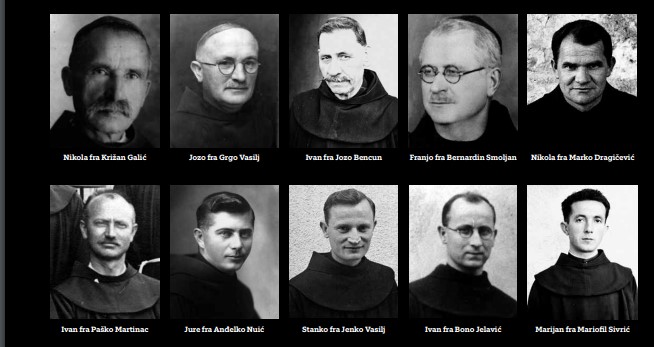
Ten of the 66 Franciscans killed are in some way connected with Medjugorje: either they were born there, or they
used to work as pastoral workers in Medjugorje. These are Fr. Jozo Bencun, Fr. Marko
Dragićević (senior), Fr. Mariofil Sivrić, Fr. Grgo Vasilj, Fr. Jenko Vasilj, Fr. Križan
Galić, Fr. Bono Jelavić, Fr. Paško Martinac, Fr. Anđelko Nuić and Fr.
Here is the information that is known about them:
Nikola fra Križan Galić (Gorica, 1870) was executed by hand grenade on October
30, 1944 in the parish apartment. He was buried in the Kovačica cemetery in Medjugorje.
On Holy Wednesday, February 14, 1945, the partisans entered Mostar without firing a bullet.
Some are officers came to the Franciscan monastery around 4 p.m. Seven Franciscans said
they were following them. They were taken away and most likely tied with wire or killed, then
thrown into the Neretva and their graves are unknown. Among them were:
Jozo fra Grgo Vasilj (Medjugorje, 1886), guardian;
Ivan Fr. Jozo Bencun (Medjugorje, 1869), former parish priest;
Franjo fra Bernardin Smoljan (Rodoč, 1884), parish priest in Humac.
Marko fra Dragičević (Medjugorje, 1902), professor of classical languages at the Franciscan
Gymnasium in Široki Brijeg, killed in Izbično - 11 (12) February 1945.
Ivan fra Paško Martinac (Čerin) - killed on February 7 or 10 in Ljubuški.
Jure fra Anđelko Nuić (Drinovci, 1908), parish vicar executed at Bleiburg in the second half
of May or later in 1945.
Stanko Fr. Jenko Vasilj (Medjugorje, 1914), religious teacher in Konjic - on the run from the
partisans he was captured in Slovenia and killed in May 1945.
Ivan fra Bono Jelavić (February 1898), pastor of Vitina, was killed on the Way of the Cross. His
grave is unknown.
Mariofil Sivrić (Medjugorje, 1913), vicar of the monastery, most likely separated from
this group and taken away later, on February 10, 1945. His dead body was found separately,
on the way to Vitina.
The blood of martyrs is the seed of Christians .
Sanquis martyrum - semen christianorum (Tertullian).
Saint John Paul II reminds Christians not to forget their martyrs because they are
witnesses to the faith.. They are our special advocates before the Lord and the power
of their intercession is extremely strong before the face of God….
In the parish of Medjugorje, life under communist rule was hard. People were beaten and sentenced to
years in prison just because they were Catholics and Croatians. In schools, just as elsewhere in Croatia,
the communists tried to separate children from their national identity and their faith. Thanks to the
strong faith of the people, they didn't succeed in this.
At the same time, the area was systematically economically neglected, with the aim of having as many
people as possible leave the area… The pilgrims, who came here at the very beginning of the apparitions,
saw all this in action. They found here a very poor region and very rude policemen. The administration
didn't permit the slightest help in accommodating the pilgrims; instead, many of them - together with
the locals - were persecuted and imprisoned, just because they said that Our Lady was appearing.
However, the local people were hospitable and had their standards.
7. Liberation
The communist tyranny fell in 1990, when the Croatian people unanimously decided for the independence
and breakaway from the artificially created Yugoslavia. This, certainly, didn't tie in with the idea
of Great Serbian, so the Yugoslavian army, made up primarily of Serbs, militarily attacked Slovenia on
the 25th of June 1991 (the tenth anniversary of Our Lady's apparitions), then Croatia and afterwards
Bosnia and Herzegovina, desiring to suffocate independence.
Several hundred thousands lost their lives during this bloody war. The world could have stopped this bloodshed.
It didn't do this because of their respective interests. The E.E.C. kept on condemning the warring sides,
hoping to wash its hands and save Yugoslavia as a multinational state, which could be used to further
their own aims. James Baker, the Prime Minister of the Bush administration, even permitted the Yugoslav
army to attack Slovenia.
European and world powers sought out and still seek their own interests in these areas. Because of that,
they tried and continue to try to fog-up this war presenting it as a civil war in which all were equal.
The truth is, however, completely different and very simple: The Serbs, wanting to create the Great Serbia,
attacked other peoples which up until then had lived with them in the same state.
They were able to do this because, in ex-Yugoslavia, all the power was in their hands. The major world
powers had chosen them as the "policemen" of the Balkans, and because of this, they looked benignly on
their actions. Even when they had committed the first genocide, as in Vukovar, the major world powers
didn't want to stop them. They only began to stop them when they exceeded every measure, and began to
injure the reputation of their protectors.
The warfare between Croatians and the Moslem community in Bosnia and Herzegovina (in 1993) began as a
series of misunderstandings, but also out of a desire of some foreign intelligence services to occupy
as much as possible of the territories in Bosnia and Herzegovina and to consolidate there. The Croatians
simply desired that no one other than themselves govern them anymore. They wanted to have their own schools,
to be allowed to call their own language Croatian, while remaining in Bosnia and Herzegovina.
The Moslem community, the largest in Bosnia and Herzegovina, led by a fundamentalist leadership, wanted to
administrate the new state according to the Islamic law and to impose its rule upon the others.
For this reason, they brought into the country the Islamic soldiers - mudjahedins - from all over the
world, who committed terrible crimes in Bosnia and Herzegovina. This war, however, was stopped very
rapidly because it was really not needed.
The horrors of the 1991-1995 war and hatred towards the Catholic Church and Croats can also be seen in the
number of destroyed or damaged sacral buildings:
In Croatia, 380 churches and chapels were destroyed during the 4 years of the war, and 215 were damaged.
5 monasteries were severely damaged, and 39 lightly. 2 priests were killed.
In Bosnia and Herzegovina, 350 churches and chapels were destroyed, 239 were damaged. 22 monasteries
were severely damaged. 8 priests and 1 nun were killed.

Franciscan Church of St. Philip and St. James and monastery, Vukovar, Croatia
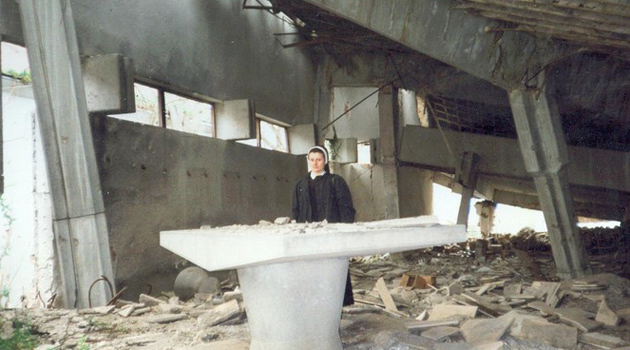
Church of St. George, Derventa, Bosnia and Herzegovina
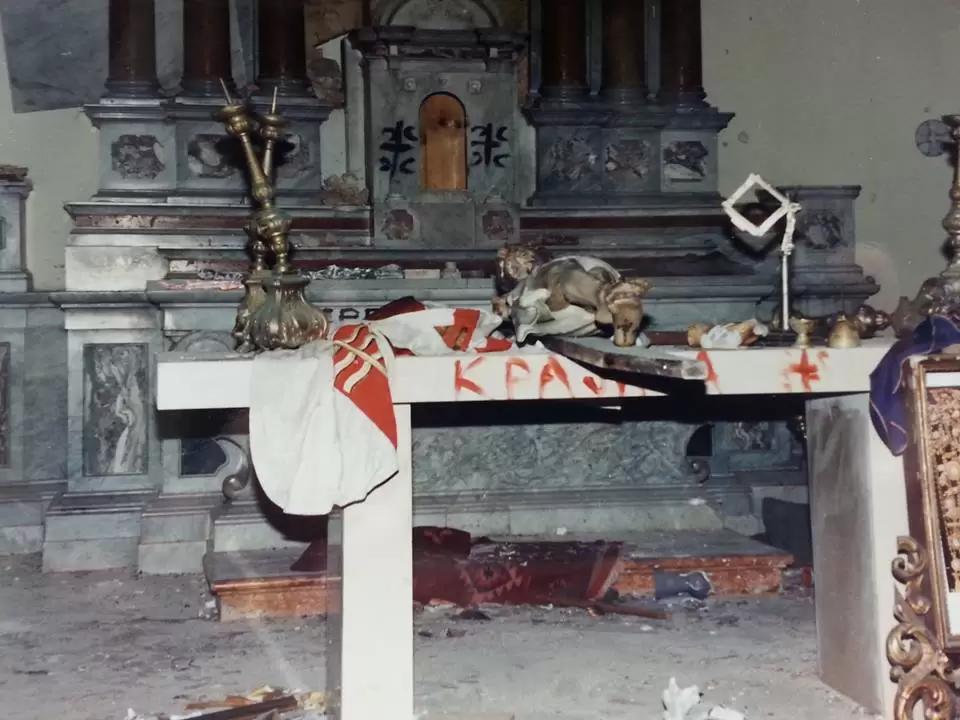
Church of St. Anthony, Knin, Croatia
Today, Medjugorje is a part of the state of Bosnia and Herzegovina. Because of the communist administration
and the terrible war, the infrastructure of Medjugorje is still underdeveloped. This however, didn't stop pilgrims
from coming here, even during the cruelest clashes of the war. Many of them brought aid, thus helping the Croatian
people to remain where they were. The Croatian people will never forget this. Today, pilgrims are coming more and more.
They want to experience this time of grace with their whole hearts, and not let it pass them by.













